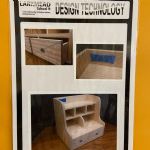D & T
Head of Faculty: Mr Stevens - HSTEVENS@LARKMEAD.VALE-ACADEMY.ORG
Key Stage 3
Key Stage 3 consists of students in years 7 and 8. In this time we aim to provide the students with the skills they will need for GCSE, completing smaller projects, learning the design process and gaining knowledge about the different specialist areas of Design Technology we teach.
In Key Stage 3 our students move through 3 different specialist areas each year, these consist of Resistant Materials, Food Technology and Graphic Products.
Each lasts for 13 weeks and in this time the students produce both, a product and written work to assist with their learning.
Year 9 – Transition
Students get to practice the core skills needed for GCSE. They study the key mathematical principles associated with product design and start to apply some of the theory, which underpins all disciplines.
Key Stage 4 – Resistant Materials
What will my child learn in Resistant Materials?
Students will be able to design and make products, with creativity and originality in a variety of practical activities, using a range of materials and techniques. They will acquire a working knowledge of woods, metals, plastics and composite materials.
How is Design and Technology – Resistant Materials taught?
There will be a number of set design tasks that will allow students to experience the different materials and tools that can be used in this area. At the end of year ten a more open ended design task will be set allowing students to practice the skills they will need for year eleven and the practical GCSE project. It is anticipated that there will be one group of mixed ability pupils, with two double lessons and one single a fortnight. Students will experience wood, metal and plastics through a range of projects which will build on the techniques demonstrated by teaching staff.
Key Stage 4 – Graphics
What will my child learn in Design and Technology – Graphic Products?
Students will be able to design and make products, with creativity and originality in a variety of practical activities, using a range of graphic and modelling materials and new technologies.
How is Design and Technology – Graphic Products taught?
Students will use technical drawing skills learnt in Years 7 to 9 to create a variety of design projects. Computers will be used to investigate and develop their design. Students will make products and use digital photography to show how their design develops. It is anticipated that there will be one group of mixed ability pupils. D&T Graphics will be taught in single lessons.
Key Stage 4 – Electronics
What will my child learn in Design and Technology – Systems and Control?
Students will be able to design and make products, with creativity and originality in a variety of practical activities, using a range of control systems including electronic sensors, pneumatics and mechanisms. They will acquire a working knowledge of PCB manufacture and design layout as well as the function of electronic components and mechanisms.
How will Design and Technology – Systems and Control be taught?
There will be a number of set design tasks that will allow students to experience the different materials and electronic components that can be used in this area. At the end of year ten a more open ended design task will be set allowing students to practice the skills they will need for year eleven and their practical GCSE project. It is anticipated that there will be one group of mixed ability pupils. D&T systems and control will be taught in single lessons.
Key Stage 5 – Product Design
What will my child learn in A-Level Systems and Control
The Product Design course has been designed to encourage students to take a broad view of design and technology. It also helps students to participate in and think about tomorrow’s rapidly changing technologies, and to intervene creatively to improve their quality.
The Product Design A-Level course follows a similar format to that of Design & Technology GCSEs. Students will be required to complete a series of modular components, including practical controlled assessment tasks and examination elements. However, unlike the GCSE course, the weighting of these modules is more evenly spread, with the examination components carrying the same percentage of the overall course as the practical controlled assessment tasks.
D&T Display Work

